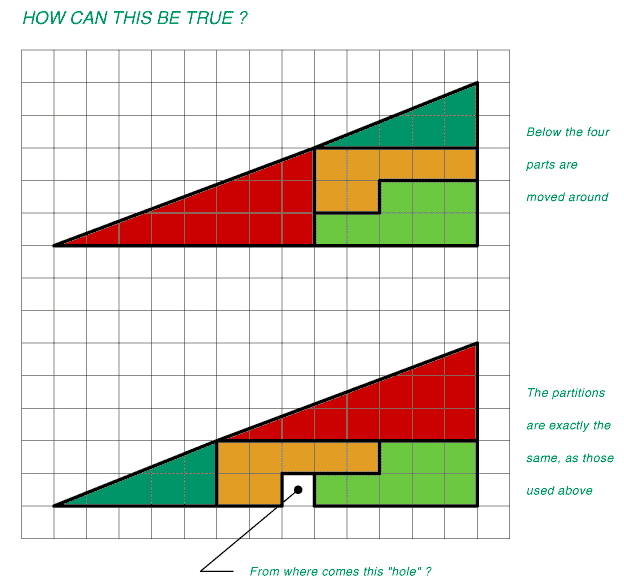Bo Liao Questions For Bo Lian ppl
-
The F Illusion
How many Fs do you see in the text below?
FINISHED FILES ARE THE RE-
SULT OF YEARS OF SCIENTIF-
IC STUDY COMBINED WITH THE
EXPERIENCE OF YEARS. -
6

-
the missing dollar
Three men decided to split the cost of a hotel room. The hotel manager gave them a price of $30.
The men split the bill evenly, each paying $10, and went to their room. However, the hotel manager realized that it was a Wednesday night, which meant the hotel had a special: rooms were only $25. He had overcharged them $5!
He called the bellboy, gave him five one-dollar bills and told him to return it to the men.
When the bellboy explained the situation to the men, they were so pleased at the honesty of the establishment that they promptly tipped the bellboy $2 of the $5 he had returned and each kept $1 for himself.
So each of the three men ended up paying $9 (their original $10, minus $1 back) totalling $27, plus $2 for the bellboy makes $29.
Where did the extra dollar go? -
3?

-
6 F........

-
mi anyhow type 1Originally posted by duotiga83:3?

-

-
7 F
-
wow ... ah ma gd leh ....Originally posted by Xiao Long Nu:6
-
hmm... maths error.
-
Originally posted by dotsg:wow ... ah ma gd leh ....

-
The LOGIC there lies in that you're doing a BACKWARD COUNT and not a normal FORWARD COUNT. Or also known as the SUBTRACTIVE COUNT for the former and ADDITION COUNT for the latter.Originally posted by dotsg:the missing dollar
Three men decided to split the cost of a hotel room. The hotel manager gave them a price of $30.
The men split the bill evenly, each paying $10, and went to their room. However, the hotel manager realized that it was a Wednesday night, which meant the hotel had a special: rooms were only $25. He had overcharged them $5!
He called the bellboy, gave him five one-dollar bills and told him to return it to the men.
When the bellboy explained the situation to the men, they were so pleased at the honesty of the establishment that they promptly tipped the bellboy $2 of the $5 he had returned and each kept $1 for himself.
So each of the three men ended up paying $9 (their original $10, minus $1 back) totalling $27, plus $2 for the bellboy makes $29.
Where did the extra dollar go?
You considered that each man paid $10 totalling $30. Take into account of $1 tips make which of them pay $9. $27? What ya didn't consider is the $2 given to the bellboy which makes their total spending on the hotel ALONE $25 <- SUBTRACTIVE move.
If you've decided to add $2 to account for the tips given to the bellboy at the point of $27. You'll realise that if the guys throw back their individual $1 to the $27 again there'll be $30. The $2 tips is to be SUBTRACTED from the $30 total to begin with. You're not taking the $2 tips FROM the bellboy, hence you cannot add the $2 to the SUBTRACTIVE TOTAL of $27. -
first time see devil so bo liao

-
If you have a higher resolution scale of the above figures you most probably would be able to see that the 2nd figure (below) don't fit the scale very well... (which won't be seen much from this illustration shown)Originally posted by dotsg:
The tiny amount has resulted in the MISSING PIECE. -
I can't stand LOGIC being ABUSED...?Originally posted by Xiao Long Nu:first time see devil so bo liao

-
Aiyah, no need the resolution and all that.. just think of it as Similar Triangles..
The 2 triangles aren't similar.. the 2 sides which make up the right angles have the ratios of 3/8 and 2/5 which are not equal so the line which make up the hypothenou... (dunno how to spell) the long side of the right-angle triangle, is not a straight line Originally posted by Devil1976:If you have a higher resolution scale of the above figures you most probably would be able to see that the 2nd figure (below) don't fit the scale very well... (which won't be seen much from this illustration shown)
Originally posted by Devil1976:If you have a higher resolution scale of the above figures you most probably would be able to see that the 2nd figure (below) don't fit the scale very well... (which won't be seen much from this illustration shown)
The tiny amount has resulted in the MISSING PIECE.